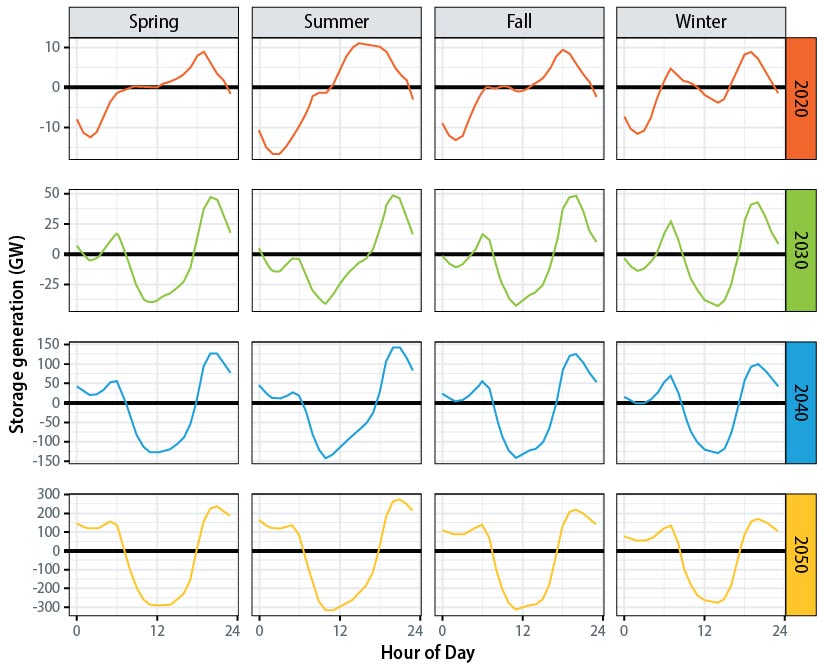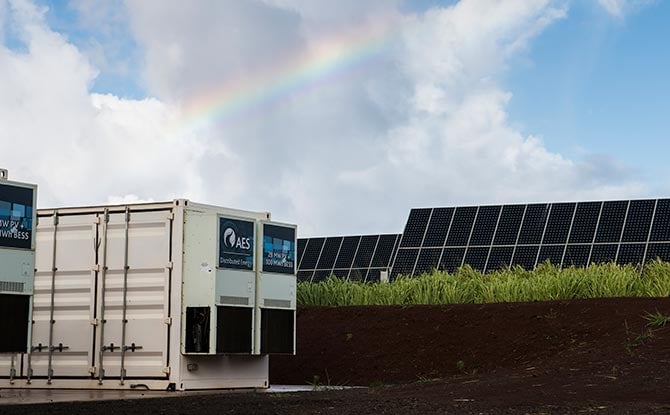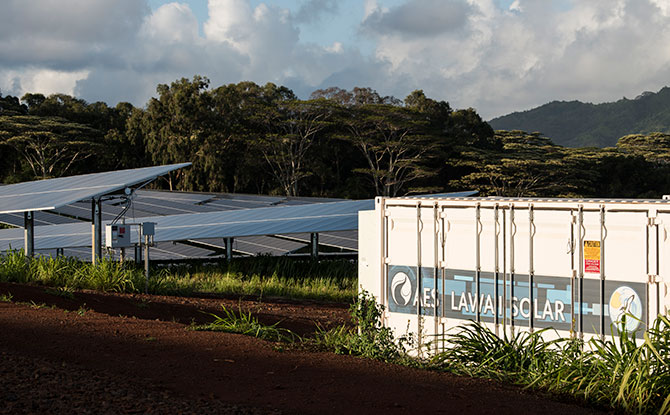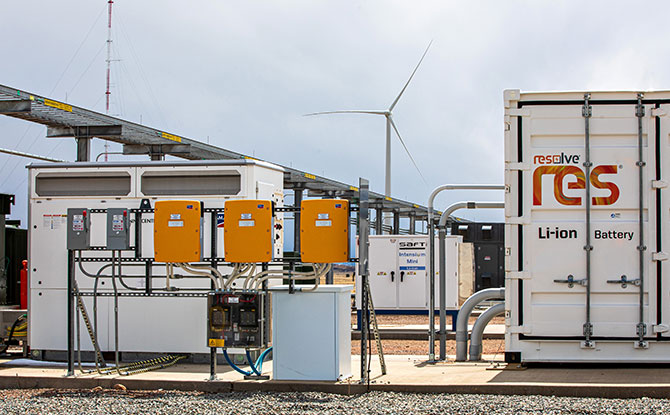Storage Futures Study
The Storage Futures Study (SFS) considered when and where a range of storage technologies are cost-competitive, depending on how they're operated and what services they provide for the grid.
Through the SFS, NREL analyzed the potentially fundamental role of energy storage in maintaining a resilient, flexible, and low carbon U.S. power grid through the year 2050.
In this multiyear study, analysts leveraged NREL energy storage projects, data, and tools to explore the role and impact of relevant and emerging energy storage technologies in the U.S. power sector across a range of potential future cost and performance scenarios through the year 2050.
The SFS—supported by the U.S. Department of Energy's Energy Storage Grand Challenge—was designed to examine the potential impact of energy storage technology advancement on the deployment of utility-scale storage and the adoption of distributed storage, as well as the implications for future power system operations.

The SFS considers when and where a range of storage technologies are cost-competitive, depending on how they're operated and what services they provide for the grid.
Publications
Technical Report: Moving Beyond 4-Hour Li-Ion Batteries: Challenges and Opportunities for Long(er)-Duration Energy Storage
This report is a continuation of the Storage Futures Study and explores the factors driving the transition from recent storage deployments with 4 or fewer hours to deployments of storage with greater than 4 hours. The report specifically builds on the first publication in the series, The Four Phases of Storage Deployment: A Framework for the Expanding Role of Storage in the U.S. Power System, and delves into Phases 2 and 3. In these phases, solar photovoltaics and storage increase the value of each other, and lower costs and technology improvements enable storage to be cost-competitive while serving longer-duration applications.
Technical Report: Key Learnings for the Coming Decades
Webinar: Watch the Key Learnings recording and view the Key Learnings presentation slides
Drawing on analysis from across the two-year Storage Futures Study, the final report in the series, released April 2022, summarizes eight key learnings about the coming decades of energy storage. The key conclusion of the research is that deployment of energy storage has the potential to increase significantly—reaching at least five times today’s capacity by 2050—and storage will likely play an integral role in determining the cost-optimal grid mix of the future. These key learnings can help policy makers, technology developers, and grid operators prepare for the coming wave of storage deployment.
Technical Report: Grid Operational Impacts of Widespread Storage Deployment
Webinar: Watch the Grid Operational Impacts recording and view the Grid Operational Impacts presentation slides
Released January 2022, the sixth report in the series focuses on how the grid could operate with high levels of energy storage. NREL used its publicly available Regional Energy Deployment System (ReEDS) model to identify least-cost generation, energy storage, and transmission portfolios. Then, operation of these assets is simulated using a commercially available production cost model called PLEXOS. The modeling shows the high value of energy storage in peaker-type applications. Storage also increases the efficiency of different types of generation assets by reducing overgeneration from PV and wind and reducing costly start-ups of thermal generators.

Technical Report: The Challenge of Defining Long-Duration Energy Storage
The fifth report in the series, released November 2021, describes the challenge of a single uniform definition for long-duration energy storage, or LDES, that reflects both duration and application of the stored energy. NREL was not able to determine a single uniform definition for LDES to describe both duration and application and concludes it may not be possible to reconcile the two. The team suggests any use of the term LDES should be accompanied with a short qualitative description to clarify the intent of using the term. And if a duration must be used, the team recommends using ARPA-E’s definition of 10–100 hours but with the appropriate caveats.
Technical Report: Distributed Solar and Storage Outlook: Methodology and Scenarios
Webinar: Watch the Distributed Solar and Storage recording and view the Distributed Solar and Storage presentation slides
The fourth report in the series, released July 2021, examines the drivers of customer adoption of behind-the-meter battery storage. Analysts expanded capabilities of NREL's Distributed Generation Market Demand model to simulate customer decisions about whether to adopt distributed storage paired with PV under different scenarios. These scenarios use technology cost and performance assumptions consistent with the 2020 NREL Standard Scenarios paired with updated battery cost projections and existing policies. Additional scenarios evaluate sensitivities to the value of backup power and distributed energy resource compensation mechanisms, collectively characterizing the future potential for behind-the-meter storage and identifying key drivers of adoption.
Technical Report: Economic Potential of Diurnal Storage in the U.S. Power Sector
Data: U.S. economic potential of diurnal storage data
Webinar: Watch the Economic Potential of Diurnal Storage recording and view the Economic Potential of Diurnal Storage presentation slides
The third report in the series, released May 2021, models the evolution of diurnal storage (<12 hours) within the U.S. electricity sector through 2050 using a least-cost optimization framework. Analysts find significant market potential for diurnal energy storage across a variety of scenarios using different cost and performance assumptions for storage, wind, solar photovoltaics (PV), and natural gas. Across all scenarios modelled, energy storage deployment exceeds 125 gigawatts by 2050, more than a five-fold increase from 23 gigawatts (all of which is pumped-hydro) of installed capacity in 2020. Depending on cost trajectories and other variables, 2050 storage deployment totals up to 680 gigawatts, largely driven by system flexibility and greater PV penetration on the grid.
Technical Report: Energy Storage Technology Modeling Input Data
Data: Model input data
The second report in the series, released May 2021, provides a broad view of energy storage technologies and inputs for forthcoming reports that will feature scenario analysis. This report also presents a synthesis of current cost and performance characteristics of energy storage technologies for storage durations ranging from minutes to months and includes mechanical, thermal, and electrochemical storage technologies for the electricity sector. The analysis covers a broad range of storage technologies that are currently receiving significant attention from the investment community, as well as in the media. In addition, for a smaller set of technologies—primarily lithium-ion batteries—this report provides current and future cost trends until 2050, which is intended for scenario analysis at both the bulk power and distribution system scales.
Technical Report: The Four Phases of Utility-Scale Energy Storage Deployment: A Framework for the Expanding Role of Storage in the U.S. Power System
Webinar: Watch the Four Phases recording and view the Four Phases presentation slides
Released January 2021, the first report in the SFS series presents a first-of-its-kind visionary framework for the possible evolution of the stationary energy storage industry—and the power system as a whole. The vision outlines four phases from shorter to longer storage duration, which could result in hundreds of gigawatts of installed capacity and a significant shift in our electric grid, helping utilities, regulators, and developers plan for the future. Many concepts presented in the report will be further explored in upcoming SFS studies, including detailed results of the modeling and analysis of power system evolution scenarios and their operational implications.
| Phase | Primary Services | National Deployment Potential (Capacity) in Each Phase | Duration | Response Speed |
|---|---|---|---|---|
| Deployment prior to 2010 | Peaking capacity, energy time-shifting, and operating reserves | 23 GW of pumped storage hydropower | Mostly 8–12 hr | Varies |
| 1 | Operating reserves | <30 GW | <1 hr | Milliseconds to seconds |
| 2 | Peaking capacity | 30–100 GW, strongly linked to photovoltaics deployment | 2–6 hr | Minutes |
| 3 | Diurnal capacity and energy time shifting | 100+ GW; depends on both Phase 2 and deployment of variable renewable energy resources | 4–12 hr | Minutes |
| 4 | Multiday to seasonal capacity and energy time-shifting | Zero to more than 250 gigawatts | >12 hr | Minutes |
In the News
The Storage Futures Study is featured in news. Read recent articles and publications that highlight the study.
Supporting Data and Analysis
Under the SFS, researchers are leveraging supporting NREL data and analyses to study energy storage technologies at unprecedented scale:
Technical Review Committee
To develop and refine the highest priorities, the SFS partners with a technical review committee, including the University of Maryland, Stanford University, Argonne National Laboratory, Pacific Northwest National Laboratory, NextEra Analytics, Massachusetts Institute of Technology, Federal Energy Regulatory Commission, New York Independent System Operator, Fluence Energy, Carnegie Mellon University, First Solar, Imperial College- London, U.S. Environmental Protection Agency, Lawrence Berkeley National Laboratory, U.S. Energy Information Agency, and Xcel Energy.
Contact
Share
Last Updated April 21, 2025




